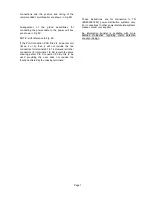
Page vii
Detector Precautions
!
CAUTION
During installation and operation of the detector the following points must be considered. Failure to do so may
result in difficulties of operation, degradation in the performance or damage occurring to your detector.
1.
Electric Arc Welding
Electric Arc Welding must not be carried out on the detector or on any part of the attached conveyor
system.
If Electric Arc Welding must be carried out on any attached systems, disconnect and remove the detector
head and detector power supply box prior to welding.
2.
Power Source
It is recommended that the power source should be taken from a source which supplies only low power
equipment.
It is recommended that the detector should not be connected to power sources which are supplying
varying current loads, e.g. Invertors, variable-speed drives etc.
It is recommended that the power source for the detector should be connected via an independent spur.
The power source for the detector should be fitted with an isolation switch and the appropriate circuit
breaker and/or fuse.
3.
Electromagnetic Interference
It is recommended that the detector should not be installed in close proximity to any devices which may
emit electromagnetic interference e.g. Radio transmitters.
Ensure all Inverters and variable-speed drives in the proximity of the detector are installed in full
accordance with their manufacturers instructions.
Where possible avoid placing any cables from Inverters, variable-speed drives etc. in close proximity to
the detector or the detector cables.
In particular take care to avoid placing the detector in the proximity of any equipment that generates
electromagnetic interference in the same frequency range as the detector.
4.
Magnetic Fields (Ferrous Detectors Only
)
It is recommended that this type of detector should not be installed in close proximity to any potential
source of magnetic fields.
5. Metal Free Zone (M.F.Z.)
To achieve the optimum detector performance, an area surrounding the aperture of the detector known
as the Metal Free Zone (M.F.Z.) must be kept free of metal.
The size of this zone will be dependant upon the type of detector, the detector’s aperture height and the
detector’s operating sensitivity.
Stationary metal may be positioned closer to the detector than moving metal.
Typical values of M.F.Z for standard metal detectors are:
M.F.Z. = 1.5 x aperture-height for stationary metal
M.F.Z. = 2.0 x aperture-height for moving metal.
Typical values of M.F.Z for Ferrous detectors are:
M.F.Z. = 1.5 x aperture-height for stationary non-Ferrous metal
M.F.Z. = 2.0 x aperture-height for moving non-Ferrous metal.
M.F.Z. = 2.0 x aperture-height for stationary Ferrous metal
M.F.Z. = 3.0 x aperture-height for moving Ferrous metal.
Summary of Contents for STANDARD SERIES
Page 11: ......
Page 22: ...Figure 6C Cable Gland Assemblies for Power Supply Unit Page 9A...
Page 23: ...Figure 8 Bearing Block Insulation Figure 7 Roller Shaft Insulation one end only Page 9B...
Page 24: ...THIS PAGE IS LEFT BLANK INTENTIONALLY Page 9C...
Page 25: ...Page 10...
Page 26: ......








































